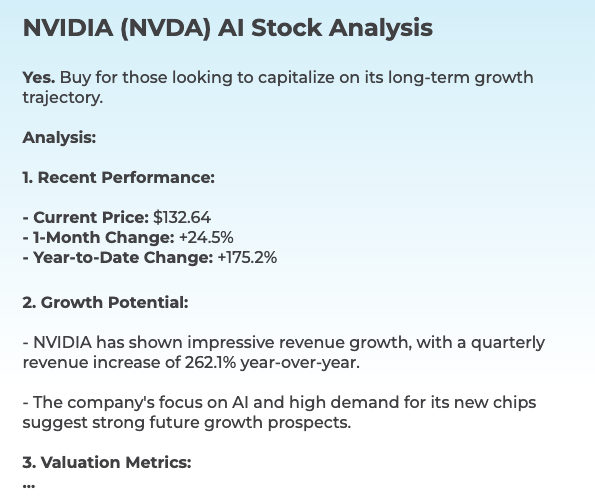20 Excellent Facts For Selecting AI Stock Trading Platform Sites
20 Excellent Facts For Selecting AI Stock Trading Platform Sites
Blog Article
Top 10 Ways To Evaluate The User Experience And Interface Of Ai Stock Trading Platforms
The User Interfaces (UI) and the user experiences of AI-powered stock trading platforms is essential for their usability, efficiency, overall satisfaction, and overall success. An undesigned interface could affect decision-making, even when the core AI models are reliable. Here are the top 10 suggestions for assessing the UI/UX of these platforms:
1. Evaluation of intuitiveness and ease of use
Navigation: Make it simple to navigate the platform with menus, workflows and buttons.
Learning curve: Assess the speed at which a novice user can comprehend and utilize the platform with no any extensive training.
Consistency - Examine the patterns of design across all platforms to ensure consistency (e.g. button colors and styles).
2. Make sure you check for customizability.
Dashboard customization: Verify whether users are able to customize dashboards to display relevant information as well as charts and metrics.
Flexibility in layout is essential You should be able to change the layout and size of charts, widgets, and tables.
Look up the platform's dark/light choices or preferences for visuals.
3. Visualize Data
Chart quality. Ensure that your platform has top-quality interactive charts (e.g. Candlestick charts and Line charts) with zooming/panning functionality.
Visual clarity: Ensure the information is clearly presented with labels, legends, and tooltips.
Real-time Updates: Check to see whether your graphs are updated with the most current market information.
4. Speed and Test Responsiveness
When working with huge datasets and complex calculations, the platform should load quickly.
Real-time performance: Check if your platform is able to handle feeds of data that are updated in real-time without lags or delays.
Cross-device compatibility : Find out if the platform is compatible with all devices (desktops mobiles, tablets, desktops).
5. Accessibility must be assessed
Mobile app accessibility: See whether the platform provides an app for mobile devices that has full functionality for on-the-go trading.
Keyboard shortcuts. Check to see if the platform provides keyboard shortcuts to power users.
Accessibility features. Check the platform's conformity with accessibility standards.
6. You can sort and search your results.
Searching functionality: Ensure that your platform permits you to quickly search for stocks, indexes, and other assets.
Advanced filters: Find out whether there are filters that can be applied to the results.
Saved searches: Check if you can save searches and filters that are frequently used.
7. Check for Alerts & Notifications
Customizable alarms: Ensure that users have the ability to set up alarms to be specific for certain conditions.
Notification delivery: Make sure that alerts are being sent through multiple channels, e.g. SMS, email or in-app notifications.
Timeliness - Make sure that alerts are issued promptly and accurately.
8. Evaluation of Integration with Other Tools
Broker integration: Ensure the platform integrates seamlessly with your brokerage account to allow simple trading execution.
API access: Find out whether the platform provides API access to advanced users to build customized workflows or tools.
Third-party integrations: Determine whether the platform allows integrations with other applications (e.g., Excel, Google Sheets and trading bots).
9. Evaluate Help and Support Features
Go through the onboarding videos.
Help center: Make sure the platform has a complete knowledge base or a help center.
Customer support: Find out if there is a responsive customer service (e.g. live chat, email or phone).
10. Test Overall Customer Satisfaction
Feedback from users: Read research reviews and testimonials to gauge general satisfaction of users with the platform's interface and user experience.
Trial period: Take advantage of the demo or trial version for free to try the platform out for yourself and assess its usability.
Check the platform's error handling.
Bonus Tips
Aesthetics. The functionality is important but a visually appealing layout can enhance the experience of users.
Performance under stress Test the platform under high-volatility market conditions to ensure it remains solid and agile.
Find active forums and communities. Users can post their tips and feedback in these areas.
These tips will aid you in evaluating the user interface and UX of the AI stock-predicting/analyzing trading platform to ensure they're user-friendly, efficient and in line with your trading needs. A great UI/UX will enhance the ability of you to make educated decisions, and to effectively execute trades. Read the top ai investing platform advice for website info including best ai stock trading bot free, best ai stock trading bot free, ai investment platform, ai chart analysis, options ai, ai stock market, ai investment app, ai trading tools, ai for stock predictions, ai stock market and more.
Top 10 Suggestions For Evaluating The Accuracy And Scalability Of Stock Trading Platforms Based On Ai
Scalability is a crucial factor in determining whether AI-driven platforms for stock forecasting and trading can handle growing demand from users, increasing markets and data volumes. These are the top 10 tips to assess scalability:
1. Evaluate Data Handling Capacity
Tips: Determine if the platform has the ability to analyze and process large databases.
Why: Scalable systems must manage data volumes that are growing without performance degradation.
2. Check out real-time processing capabilities
Check out how well your platform is able to handle real-time streams of data such as live stock quotes, or breaking news.
Why the trading decision is made in real-time and delays could cause traders to miss opportunities.
3. Cloud Infrastructure and Elasticity The Cloud Infrastructure and Elasticity
Tips. Find out if the platform utilizes cloud-based infrastructure, such as AWS, Google Cloud and Azure which are able to expand resources according to demand.
Why cloud platforms are so popular: They provide flexibility, allowing the system to scale up or down based on demand.
4. Algorithm Efficiency
Tips: Find out the effectiveness of AI models employed to predict (e.g. Deep Learning and Reinforcement Learning).
Why: Complex algorithms can be resource-intensive, and optimizing them is crucial to scaling.
5. Explore the possibilities of Parallel Processing and distributed computing
Make sure the platform is using distributed computing or parallel computing frameworks.
What is the reason? They can speed up data processing across many nodes.
Examine API Integration, and Interoperability
Tips Try to test the platform's capacity to integrate with external APIs (e.g. brokerage APIs, market data providers APIs).
Why? Because the platform can adapt to the changing requirements of markets and sources of data thanks to seamless integration.
7. Analyze User Load Handling
To test the effectiveness of your platform, simulate high traffic.
The reason: The performance of a scalable platform shouldn't be affected by the growth in users.
8. Evaluation of Model Retraining and Adaptability
Tip: Determine how often and how effectively AI models are re-trained using new data.
Why: Markets evolve, and models must adapt quickly to keep their the accuracy.
9. Verify that Fault-Tolerance and Redundancy are in place.
Tips: Make sure the platform is equipped with failover mechanisms and redundancy in case of hardware or software issues.
Why: Because downtime is costly in trading and trading, fault tolerance is essential for the ability to scale.
10. Monitor Cost Efficiency
Tips: Calculate the costs of scaling your platform. Consider cloud resources, data storage, and computational power.
Reason: Scalability should not be a burden that is unsustainable So balancing performance and cost is crucial.
Bonus Tip Future-Proofing
Platforms should be designed to accommodate new technologies, such as quantum computing and advanced NLP. They must also adjust to regulatory changes.
Concentrating on these aspects will help you evaluate the scalability AI stock prediction and trading platform, and make sure they are durable, efficient and prepared for expansion in the future. Have a look at the top rated over here about best ai stocks to buy now for blog examples including ai stock predictions, stock predictor, best ai penny stocks, best ai stock prediction, ai investment tools, ai tools for trading, ai software stocks, ai options, ai share trading, ai for trading stocks and more.